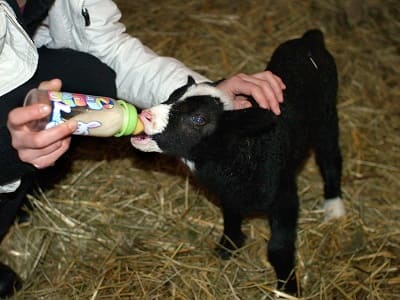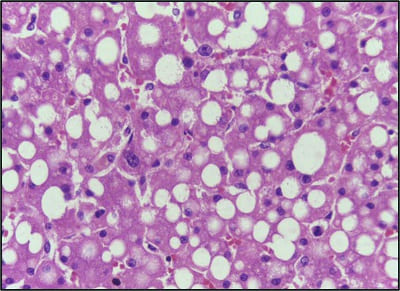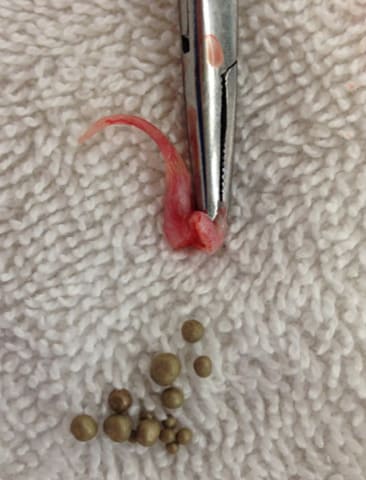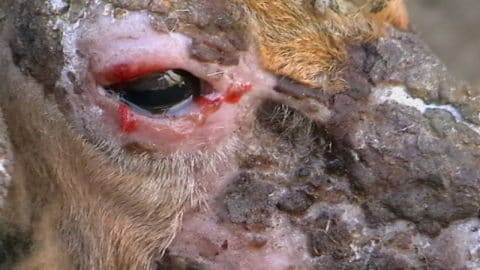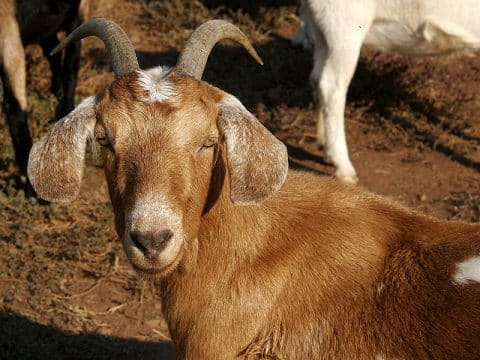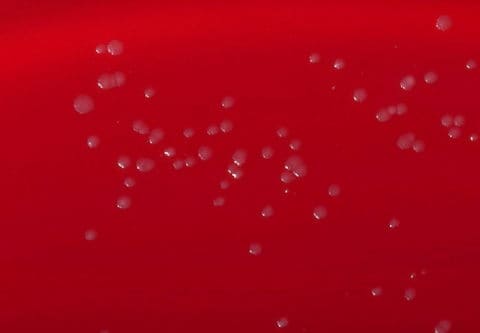For my own personal use only:
- Caprine arthritis encephalitis
(CAE)
- Classic case:
- Adults: progressive polysynovitis/arthritis
- Swollen joints (esp. carpus)
- Lameness
- Weight loss, poor hair coat
- Indurative mastitis ("hard udder"), agalactia
- Dyspnea due to interstitial pneumonia
- Kids 2-4 mos old: encephalomyelitis
- Weakness, ataxia
- Placing deficits in pelvic limbs
- Hypertonia, hyper-reflexia
- May progress to para- or tetraparesis or paralysis
- Adults: progressive polysynovitis/arthritis
- Dx:
- Etiology: Enveloped, single-stranded RNA lentivirus (family Retroviridae), very similar to ovine progressive pneumonia virus and Maedi-Visna
- Serology for herd control programs:
- Agar gel immunodiffusion (AGID) - more specific
- ELISA - more sensitive
- Definitive: biopsy or necropsy shows characteristic lymphoproliferation with degenerative mononuclear cell infiltration
- Virus isolation or PCR
- Tx: None
- Supportive care:
- Deep bedding, good quality feed
- NSAIDs, regular foot trimming
- Prevent:
- Isolate kids at birth & feed heat-treated colostrum, pasteurized milk
- Serology of herd biannually
- Separate seropositive & seronegative animals
- Eventually cull seropositive animals
- Pearls:
- Widespread in dairy goats, 65% prevalence in US herds
- Only 20% of infected goats ever show clinical signs
- Most goats infected at early age via colostrum or milk
- Clinical signs develop much later
- Horizontal transmission within herd possible
- Widespread in dairy goats, 65% prevalence in US herds
- Classic case:
- Pregnancy toxemia
- Classic case:
- Late-gestation pregnancy (last 1-3 wks)
- Dam is over- or under-conditioned
- Likely multiple fetuses
- Partial anorexia, depression
- Bruxism
- Aimless pacing, muscle tremors, opisthotonus
- Blindness, ataxia, recumbency, coma, death
- Dx:
- Ketosis: increased serum beta-hydroxybutyric acid (BHB), increased urine ketones
- +/- Hypoglycemia, hypocalcemia
- +/- Increased nonesterified fatty acids
- Necropsy: hepatic lipidosis, adrenal enlargement
- Increased BHB in aqueous humor, CSF
- Tx:
- Mild cases: Enteral/oral therapy
- Propylene glycol
- +/- Calcium, potassium
- +/- Induce parturition with steroids
- Severe cases:
- Maybe euthanasia
- Check fetal viability via ultrasound
- If alive and within 3 days of due date, perform C-section
- If dead, induce parturition with steroids
- IV therapy: dextrose, insulin, calcium, flunixin meglumine
- +/- Oral potassium
- Prevention:
- Assess body condition score (BCS) at breeding and mid-gestation pregnancy check
- Takes 6 wks to raise BCS by 1 point
- Improve feeding management:
- Adequate space
- Sort animals by BCS
- Ration formulation
- Forage analysis
- Feed grain in final 6 wks
- Do NOT enter last 6 wks pregnancy with BCS less than 2.5
- Herd screening of ~20% of flock
- Serum BHB levels should be 1.7 mmol/L high risk)
- Ionophores MAY help late-gestation
ewes improve feed efficiency
- e.g, Monensin
- Do not use in goats
- Mild cases: Enteral/oral therapy
- Pearls:
- Pregnancy toxemia develops when there is inadequate
nutrition in late gestation in the face of increased
metabolizable energy requirements
- Mobilized fat stores + increased liver gluconeogenesis passes glucose to fetus
- Can overwhelm liver leading to hepatic lipidosis & ketosis
- Prognosis is good if ambulatory with mild clinical signs
- Prognosis is guarded to poor if recumbent or comatose
- Pregnancy toxemia develops when there is inadequate
nutrition in late gestation in the face of increased
metabolizable energy requirements
- Classic case:
- Urolithiasis
- Classic case:
- Partial urethral obstruction:
- Dribbling urine
- Hematuria, stranguria
- Mineral crystals on hair around urethral orifice
- Complete urethral obstruction:
- Tenesmus, tail swishing
- Colic, weight-shifting
- +/- Bloat, rectal prolapse, inappetence, depression
- Urethral/bladder rupture
- Abdominal swelling
- Preputial swelling
- Necrosis of ventral abdominal skin with "pseudourethral" development
- Partial urethral obstruction:
- Dx:
- Usually obvious based on history/clinical signs, exam
- May see urolith in urethral process
- Abdominal ultrasound/palpation: enlarged urinary bladder unless ruptured
- Abdominal radiographs: calcium carbonate and calcium oxalate calculi are radiopaque (but struvite are radiolucent)
- Ruptured bladder:
- Abdominal ballottement of fluid wave
- Ultrasound: large volume of hypoechoic fluid in abdomen
- Abdominocentesis: creatinine of abdominal fluid is 2X that of peripheral blood
- Bloodwork: low sodium/choride, high phosphate, metabolic alkalosis
- Tx:
- If obstructed, not ruptured:
- Preferred Rx = tube cystotomy
- Calculi are expelled spontaneously over time
- If early/mild/partial:
- Try antispasmodics/tranquilizers to relax sigmoid flexure of penis
- If blockage at urethral process: amputate
- Perineal urethrostomy to bypass urolith
- Common long-term complication: stricture
- If ruptured urethra or bladder:
- Drain uroperitoneum slowly via teat cannula or trocar
- IV normal saline: correct electrolyte abnormalities, dehydration, acid-base imbalance
- Perineal urethrostomy as salvage procedure
- Cannot usually repair bladder; may heal on its own
- Usually cull within 3-4 mos
- Prevention:
- Struvite:
- Increase chloride excretion by adding sodium chloride to ration (increases water intake to dilute urine and increases chloride excretion)
- Decrease urine pH: ammonium chloride in ration
- Feed calcium:phosphorus ratio of 2:1
- Calcium stones: decrease calcium in feed
- If obstructed, not ruptured:
- Pearls:
- Common problem, esp. in males because of long urethra with sigmoid flexure
- High-grain diets with a ~1:1 calcium:phosphorus ratio or diets high in magnesium predispose
- Most often at sigmoid flexure and urethral process
- Urethroliths are most common type of urolith to cause problems
- Type that forms is based on diet
- Struvite (magnesium-ammonium-phosphate) stones: due to lots of grain with low calcium:phosphorus ratio
- Silica stones: associated with grazing on silica-rich soil
- Calcium stones: due to high-calcium diets
- Classic case:
- Copper toxicity in sheep
- Classic case:
- Acute:
- GI pain, diarrhea, anorexia, dehydration, shock
- Chronic (more common! ): no signs until ACUTE
hemolytic crisis
- Depression, lethargy, weakness, recumbency
- Rumen statis, anorexia, thirst, dyspnea
- Pale mucous membranes, hemoglobinuria, and jaundice
- Photosensitization
- If animal survives, renal failure
- Acute:
- Dx:
- Acute: at necropsy
- Blue-green ingesta
- "Gun metal"-colored kidneys, enlarged spleen
- Increased fecal or liver copper concentrations
- Chronic:
- Increased blood and liver copper concentrations
- Also measure molybdenum levels
- Acute: at necropsy
- Tx:
- Rarely successful; prognosis poor
- If acute:
- GI sedative and Rx for shock may help
- Penicillamine: enhances copper excretion
- Vitamin C: antioxidant for erythrocyte damage
- Ammonium tetrathiomolybdate: decreases liver copper absorption and increases liver copper excretion (has 10-day withdrawal)
- Molybdenum: top-dress pastures, supplement feed
- Zinc acetate, sodium thiosulfate: feed supplements that both help decrease copper absorption
- Pearls:
- Worldwide problem
- Sheep uniquely sensitive
- Excessive copper ingestion for long periods leads to
copper build-up in liver then STRESS causes sudden release
and acute hemolytic crisis
- Stress = transporation, handling, pregnancy, lactation, deteriorating plane of nutrition, weather conditions, strenuous exercise
- Sheep have increased liver enzymes for weeks before acute crisis
- Factors that affect copper metabolism:
- Low molybdenum in diet leads to excess copper retention
- Low sulfur, zinc, calcium in diet
- Subterranean clover leads to excess copper retention
- Plants such as Heliotropium europaeum or Senecio spp. contain hepatotoxic alkaloids which lead to liver disease, leading to release of copper into blood stream and hemolysis
- Always check feed labels and use correct feed for sheep!
- Classic case:
- Polled intersex syndrome
(PIS)
- Classic case:
- Most common in western European breeds: e.g., Toggenburg, Saanen, and Alpine
- Usually look male (male phenotype), but are genetically female (female genotype), with testes (or ovotestes) and dysfunctional penis
- Enlarged clitoris in a doe-like animal or decreased anogenital distance in a more masculine-appearing animal is typical
- Polled homozygotic males have decreased fertility
- Should not breed polled bucks!
- Dx: Thorough exam
- Tx: Cull, do NOT breed
- Pearls:
- Polledness is an autosomal dominant trait in males and females
- Intersexism is a recessive trait seen only in polled females
- Intersex goats are:
- Homozygous for polled trait
- Genetically female with male traits (e.g., developed testes)
- Most are NOT true hemaphrodites (e.g. those that have true testes and ovarian structures)
- PIS is very rare in cattle and sheep
- Freemartinism occurs in 20% of opposite-sex sheep twins (arteriovenous anastomoses between their placentas lead to masculinization of the female twin)
- Classic case:
-
Extra! Pizzle rot - a.k.a. enzootic posthitis and
vulvitis, enzootic balanoposthitis
- Classic case:
- Males: especially castrated males!
- Mild: preputial swelling
- Severe: preputial swelling plus
straining
to
urinate
- Scabs and ulcers around preputial orifice
- Urine accumulation in prepuce
- Fatal if urinary blockage due to chronic scarring
- Females:
- Swelling, redness of vulva and clitoris
- Scabs and ulcers of vulva, vestibule, and caudal vagina with yellow exudate
- Males: especially castrated males!
- Dx:
- Etiology: Corynebacterium renale - a gram+, diphtheroid bacterium that hydrolyzes urea
- Clinical signs
- Culture
- Tx:
- Isolate animal
- Feed low-protein diet
- Clip and clean around prepuce
- Make sure urethra is patent
- Watch for urination
- Pass catheter past scarring
- Antibiotics: penicillin or cephalosporin
- Pearls:
- High-protein diet leads to increased urea in urine causing increased ammonia produced by C. renale which causes penile/urethral irritation
- Predisposing factors:
- Dirt caked in hair around prepuce
- Preputial hairs too short or long - alters urine flow away from urethral orifice
- Seasonal incidence associated with high-protein feed intake
- Classic case:
Images courtesy of AnRo0002 (black-faced lambs), Sarah Reuss, VMD, DACVIM (uroliths), Andrei Niemimäki (bottle feeding black Finnsheep), Calicut Medical College (hepatic lipidosis), Lucien Mahin (photosensitization), Fir0002 (horned goat), CDC (bacteria), and Manhattan Research Inc (sheep nose)
Top Topic Category
Ruminants
